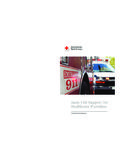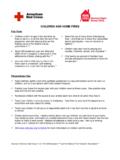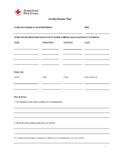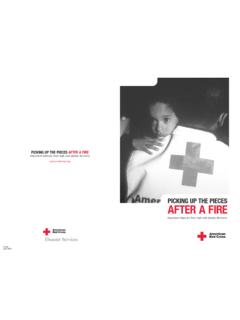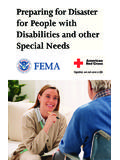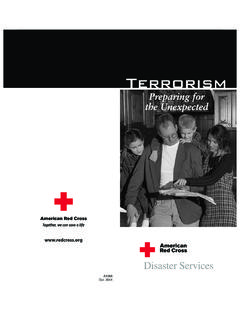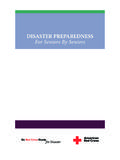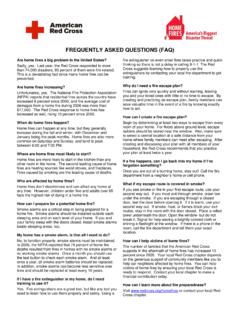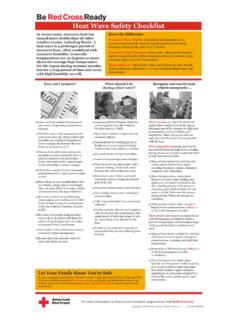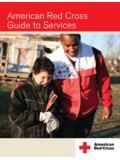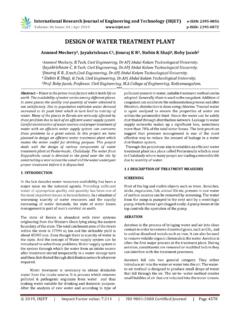Transcription of Food and Water in an Emergency - American Red Cross
1 Food and Water in an EmergencyIf an earthquake, hurricane, winter storm, or other disaster strikes your community, you might not have access to food, Water , and electricity for days or even weeks. By taking some time now to store Emergency food and Water supplies, you can provide foryour entire family. Emergency Food SuppliesEven though it is unlikely that an Emergency would cut off your food supply for two weeks, consider maintaining a supply that will last that long. You may not need to go out and buy foods to prepare an Emergency food supply. You can use the canned goods, dry mixes, and other staples on your cupboard shelves. Be sure to check expiration dates and follow the practice of first-in, first-out. Pr e P a r i n g a n em e r g e n c y Fo o d Su P Pl y As you stock food, take into account your family s unique needs and tastes.
2 Familiar foods are important. They lift morale and give a feeling of security in times of stress. Try to include foods that they will enjoy and that are also high in calories and nutrition. Foods that require no refrigeration, Water , special preparation, or cooking are best. 2 Individuals with special diets and allergies will need particular attention, as will babies, toddlers, and the elderly. Nursing mothers may need liquid formula, in case they are unable to nurse. Canned dietetic foods, juices, and soups may be helpful for ill or elderly people. Make sure you have a manual can opener and disposable utensils. Don t forget non-perishable foods for your o r a g e ti P S w Keep food in a dry, cool spot a dark area if possible. w Open food boxes and other resealable containers carefully so that you can close them tightly after each use.
3 W Wrap perishable foods, such as cookies and crackers, in plastic bags and keep them in sealed containers. w Empty open packages of sugar, dried fruits, and nuts into screw-top jars or air-tight canisters for protection from pests. w Inspect all food for signs of spoilage before use. w Throw out canned goods that become swollen, dented, or corroded. w Use foods before they go bad, and replace them with fresh supplies, dated with ink or marker. Place new items at the back of the storage area and older ones in e lF l i F e o F Fo o dS F o r St o r a g eThe following provides some general guidelines for replacement of common Emergency foods. Use within six months: w Powdered milk boxed w Dried fruit w Dry, crisp crackers w Potatoes Use within one year, or before the date indicated on the label: w Canned condensed meat and vegetable soups w Canned fruits, fruit juices, and vegetables w Ready-to-eat cereals and uncooked instant cereals w Peanut butter w Jelly w Hard candy and canned nuts w Vitamins May be stored indefinitely (in proper containers and conditions): w Wheat w Vegetable oils w Dried corn w Baking powder w Soybeans w Instant coffee, tea, and cocoa w Salt w Noncarbonated soft drinks w White rice w Bouillon products w Dry pasta w Powdered milk in nitrogen-packed cans4iF t h e el e c t r i c i t y go eS oF F.
4 FIRST ..Use perishable food from the refrigerator, pantry, garden, ..Use the foods from the freezer. To limit the number of times you open the freezer door, post a list of freezer contents on it. In a well-filled, well-insulated freezer, foods will usually still have ice crystals in their centers (meaning foods are safe to eat) for at least two days. Check to make sure the seal on your freezer door is still in good condition. FINALLY .. Begin to use non-perishable foods and w t o co o k i F t h e Po w e r go eS ou tFor Emergency cooking indoors, you can use a fireplace. A charcoal grill or camp stove can be used outdoors. You can keep cooked food hot by using candle warmers, chafing dishes, and fondue pots. Use only approved devices for warming food. Canned food can be eaten right out of the can.
5 If you heat it in the can, be sure to open the can and remove the label before heating. Always make sure to extinguish open flames before leaving the e n Fo o d Su P Pl i eS a r e lo wIf activity is reduced, healthy people can survive on half their usual food intake for an extended period and without any food for many days. Food, unlike Water , may be rationed safely, except for children and pregnant women. If your Water supply is limited, don t eat salty foods, since they will make you thirsty. Instead, eat salt-free crackers, whole grain cereals, and canned foods with high liquid content. nu t r i t i o n ti P SDuring and after a disaster, it is vital that you maintain your strength. Remember the following: w Eat at least one well-balanced meal each day. w Drink enough liquid to enable your body to function properly (two quarts or a half gallon per day).
6 W Take in enough calories to enable you to do any necessary work. w Include vitamin, mineral, and protein supplements in your stockpile to ensure adequate Emergency Water SuppliesHaving an ample supply of clean Water is a top priority in an Emergency . A normally active person needs to drink at least two quarts (half gallon) of Water each day. People in hot environments, children, nursing mothers, and ill people will require even more. You will also need Water for food preparation and hygiene. Store at least one gallon per person, per day. Consider storing at least a two-week supply of Water for each member of your family. If you are unable to store this quantity, store as much as you can. If supplies run low, never ration Water . Drink the amount you need today and try to find more for tomorrow. You can minimize the amount of Water your body needs by reducing activity and staying is recommended to purchase food-grade Water storage containers from surplus or camping supplies stores to use for Water storage.
7 If you decide to re-use storage containers, choose two-liter plastic soft drink bottles not plastic jugs or cardboard containers that have had milk or fruit juice in them. The reason is that milk protein and fruit sugars cannot be adequately removed from these containers and provide an environment for bacterial growth when Water is stored in them. Cardboard containers leak easily and Pr e P a r e a n d St o r e a n em e r g e n c y Su P Pl y o F wa t e r To prepare the safest and most reliable Emergency supply of Water , it is recommended that you purchase commercially bottled Water . Keep bottled Water in its original container, and do not open it until you need to use bottled Water in the original sealed container, and observe the expiration or use by You Are Preparing Your Own Containers of Water .
8 8are not designed for long-term storage of liquids. Also, do not use glass containers, because they are heavy and may break. w Thoroughly clean the bottles with dishwashing soap and Water , and rinse completely so there is no residual soap. w Additionally, for plastic soft drink bottles, sanitize the bottles by adding a solution of 1 teaspoon of non-scented liquid household chlorine bleach to a quart (1/4 gallon) of Water . Swish the sanitizing solution in the bottle so that it touches all surfaces. After sanitizing the bottle, thoroughly rinse out the sanitizing solution with clean Water . w Fill the bottle to the top with regular tap Water . (If your Water utility company treats your tap Water with chlorine, you do not need to add anything else to the Water to keep it clean.) If the Water you are using comes from a well or Water source that is not treated with chlorine, add two drops of non-scented liquid household chlorine bleach to each gallon of Water .
9 W Tightly close the container using the original cap. Be careful not to contaminate the cap by touching the inside of it with your fingers. Write the date on the outside of the container so that you know when you filled it. Store in a cool, dark place. w Replace the Water every six months if not using commercially bottled Water . Preparing ContainersFilling Water Containers9hi d d e n wa t e r So u r c eS i n yo u r ho m eSafe Water sources in your home include the Water in your hot- Water tank, pipes, and ice cubes. You should not use Water from toilet flush tanks or bowls, radiators, waterbeds, or swimming pools/spas. You will need to protect the Water sources already in your home from contamination if you hear reports of broken Water or sewage lines or if local officials advise you of a problem.
10 To shut off incoming Water , locate the main valve and turn it to the closed position. Be sure you and other family members know beforehand how to perform this important procedure. To use the Water in your pipes, let air into the plumbing by turning on the faucet in your home at the highest level. A small amount of Water will trickle out. Then obtain Water from the lowest faucet in the use the Water in your hot- Water tank, be sure the electricity or gas is off, and open the drain at the bottom of the tank. Start the Water flowing by turning off the Water intake valve at the tank and turning on a hot- Water faucet. Refill the tank before turning the gas or electricity back on. If the gas is turned off, a professional will be needed to turn it back on. em e r g e n c y ou t d o o r wa t e r So u r c eSIf you need to find Water outside your home, you can use these sources.
